Qualcomm Announces Snapdragon 845 Mobile Platform: Tocks Next-Gen CPU Cores, GPU, AI, & More
by Andrei Frumusanu on December 6, 2017 5:30 PM EST- Posted in
- Mobile
- Snapdragon
- Qualcomm
- Smartphones
- SoCs
- 10nm
- Snapdragon 845

Today as part of its media event, Qualcomm finally announced the much expected Snapdragon 845, successor to last year's very successful Snapdragon 835. The Snapdragon 845 is a large step in terms of SoC architectures as it's the first to employ ARM's DynamiQ CPU cluster organization. Quickly explained, DynamIQ enables the various different CPU cores within an SoC to be hosted within the same cluster and cache hierarchy, as opposed to having separate discrete clusters with no shared cache between them (with coherency instead happening over an interconnect such as ARM's CCI). This major transition is probably the largest to date that we've seen in modern mobile smartphone ARM consumer SoCs.
| Qualcomm Snapdragon Flagship SoCs 2017-2018 | |||
| SoC | Snapdragon 845 | Snapdragon 835 | |
| CPU | 4x Kryo 385 Gold (A75 derivative) @ 2.8GHz 4x256KB L2 4x Kryo 385 Silver (A55 derivative) @ 1.80GHz 4x128KB L2 2MB L3 |
4x Kryo 280 Gold (A73 derivative) @ 2.45GHz 2MB L2 4x Kryo 280 Silver (A53 derivative) @ 1.90GHz 1MB L2 |
|
| GPU | Adreno 630 | Adreno 540 @ 670/710MHz | |
| Memory | 4x 16-bit CH @ 1866MHz LPDDR4x 29.9GB/s 3MB system cache |
4x 16-bit CH @ 1866MHz LPDDR4x 29.9GB/s |
|
| ISP/Camera | Dual 14-bit Spectra 280 ISP 1x 32MP or 2x 16MP |
Dual 14-bit Spectra 180 ISP 1x 32MP or 2x 16MP |
|
| Encode/ Decode |
2160p60 10-bit H.265 720p480 |
2160p30 (2160p60 decode), 1080p120 H.264 & H.265 |
|
| Integrated Modem | Snapdragon X20 LTE (Category 18/13) DL = 1200Mbps 5x20MHz CA, 256-QAM UL = 150Mbps 2x20MHz CA, 64-QAM |
Snapdragon X16 LTE (Category 16/13) DL = 1000Mbps 3x20MHz CA, 256-QAM UL = 150Mbps 2x20MHz CA, 64-QAM |
|
| Mfc. Process | 10nm LPP | 10nm LPE | |
The CPU
The Snapdragon 835's Kryo 280 performance and efficiency cores make use of ARM's Built on ARM Cortex Technology license which allows Qualcomm to make requests to ARM to change some aspects of the architectures of newly released cores and implement these changes exclusively into Snapdragon SoCs. As such the S835's CPU cores were derivatives of ARM's Cortex A73 and Cortex A53 CPU IPs. The Snapdragon 845 being the first SoC to be based on a DynamIQ big.LITTLE CPU organization also undoubtedly suggests that the Kryo 385 CPUs are based on ARM's Cortex A75 and Cortex A55 IPs, as these are the only DynamIQ compatible CPU cores available to date.
The Kryo 385 gold/performance cluster runs at up to 2.8GHz, which is a 14% frequency increase over the 2.45GHz of the Snapdragon 835's CPU core. But we also have to remember that given that the new CPU cores are likely based on A75's we should be expecting IPC gains of up to 22-34% based on use-cases, bringing the overall expected performance improvement to 39-52%. Qualcomm promises a 25-30% increase which is at the low-end of ARM's projections.
The silver/efficiency cluster is running at 1.8GHz, this is clocked slightly slower than the A53's on the Snapdragon 835 however the maximum clocks of the efficiency cluster is mainly determined by where the efficiency curve of the performance cluster intersects. Nevertheless the efficiency cores promise 15% boost in performance compared to its predecessor.
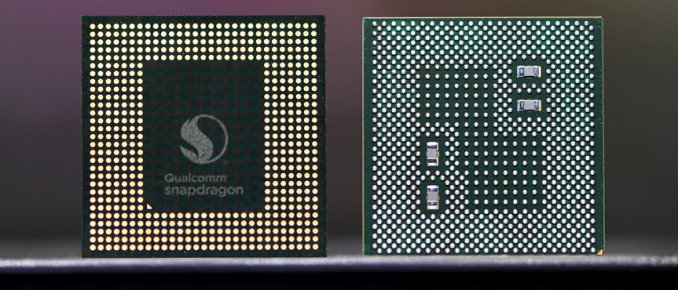
The new Snapdragon 845 now includes capacitors on its package underside
The L3 located on the DynamIQ DSU is configured at 2MB and we're likely seeing 256KB/128KB options for the performance and efficiency core private L2's. Together this would mean there's a total of 3.5MB of combined L2 and L3 cache on the CPU complex.
Qualcomm interestingly disclosed that we're only seeing three voltage and frequency planes implemented; likely meaning a single plane each for the performance cores as well as the efficiency cores as well as a plane for the L3 and DSU. This is surprising as DynamIQ allows finer grained frequency/voltage planes and given Qualcomm being traditionally a big proponent of asymmetric planes such as implemented in Krait I would have expected to see a more non-traditional approach, something that would have been facilitated given the fact that Qualcomm likes to include on-chip LDO regulators for powering the CPU clusters.
Related to the caches but not part of the CPU, there's also a new inclusion of a 3MB system cache. This is likely a SoC interconnect cache and serves all SoC blocks - likely in similar fashion the "L3" cache on Apple A-series SoCs works. This would help reduce external memory transactions and thus also reduce power to the memory controllers and DRAM. Qualcomm claims it's able to reduce memory access bandwidth by up to 40-75%, a significant figure.
The GPU
The Snapdragon 845 comes with a new generation of the Adreno GPU, called the Adreno 630. The switch from a 5xx family to a 6xx family GPU, as with previous introductions from Qualcomm usually marks the transition consisting of larger architectural changes.
Qualcomm is as usual very tight-lipped about details of its GPU but it promises a performance increase of 30% while also increasing power-efficiency by 30%. What this translates to is basically we're looking at 30% higher frame-rates while maintaining the same power consumption of the Snapdragon 835, which is an excellent improvement.
DSP Upgrade to Hexagon 685
The DSP sees a evolutionary upgrade from the 682 to the 685. Again details about the improvements are relatively sparse but Qualcomm promises improvements in power and performance, especially for AI and imaging tasks. Qualcomm made an emphasis on AI processing during the presentation and claim that the new IP achieves up to 3x increase in performance compared to the Snapdragon 835.
Traditional DSP architectures are usually not well optimized for neural network processing so we'll have to adopt a wait & see approach when it comes to the performance of the new Hexagon 685 when executing such tasks. SoCs which have a dedicated NPU such as the Apple A11 or Kirin 970 still have a large edge here as they augment the image processing pipeline instead of handing such tasks over to the DSP which might have to do double duty of both image processing (such as HDR) and image analysis via neural network processing (image recognition and classification).
Snapdragon X20 Modem Now Integrated
As is traditional with Qualcomm we first see cutting-edge modem implementations first released as independent discrete modems and only afterwards do we see them integrated into the newest high-end SoCs. The Snapdragon 845 now integrated the X20 modem released earlier in the year which we've covered in a dedicated article.
The new modem elevates the LTE UE Category to 18 as it's now capable of 5xCA as opposed to 4xCA on the X16 modem integrated in the Snapdragon 835. This allows for download speeds of up to 1.2Gbps when in a 5x20MHz downstream carrier aggregation mode, that is of course, if you're lucky enough for your mobile carrier to support such configurations.
Improved Media Capabilities
The Snapdragon 845's display pipeline receives an upgrade for VR and claims to be now able to drive dual-2400x2400p120 displays for VR headsets. The video recording capabilities have been improved as the Snapdragon 845 increases maximum video encoding framerate at 4K recording from 30 to 60fps compared to the Snapdragon 835. Qualcomm advertised support for Rec.2020 wide gamut color space recording, meaning we now see full support for HDR10 HEVC recording which should be an interesting addition I'm looking forward to test.
The new Spectra 280 ISP's most standout feature seems to be multi frame noise reduction (MFNR) which is a feature that I believe is also used in Google's HDR+ proprietary processing. The feature captures multiple pictures in fast succession and applies an algorithm to apply noise reduction in higher quality fashion compared to traditional single-frame noise reduction which can introduce blurriness.
Manufactured on Second Generation 10LPP Process
The Snapdragon 845 comes manufactured on a second generation 10LPP process from Samsung. This was a natural evolution to be expected as the Snapdragon 835 was manufactured on 10LPE. Samsung promises performance increase of up to 10% at the same power levels or reduced power consumption of up to 15% at the same performance. Samsung had just announced last week the start of mass production for 10LPP. I was rather surprised to see the larger frequency boost to 2.8GHz on the performance cores as the Snapdragon 835 came with rather conservative frequencies of only 2.45. The A75 promised increased performance at the same efficiency, meaning the core uses more power to reach the higher performance point compared to the A73.
Most devices I've seen with Snapdragon 835's used about 1.1W per core at peak using the power virus-style workload we traditionally use so seeing the Snapdragon 845 using the new processor architecture as well as increases in frequency is quite surprising as both would increase the absolute power consumption of the CPUs. The two possible scenarios we're likely to encounter is that either the Snapdragon 845 CPU complex uses more power or that Samsung has managed to vastly improve its manufacturing process over the last year to allow for such gains.
"Tock" Generation For CPU and GPU
The new Snapdragon 845 brings with itself one of the biggest architectural shifts in the ARM SoC space with the first implementation of the new DynamIQ cluster hierarchy. With an expected solid 30% performance boost on both CPU and GPU we're likely to see a healthy upgrade for 2018 flagship devices. Overall the Snapdragon 845 fulfils most of its expectations and in a time in the Android ecosystem where improvements have slowed down this is a good thing. The Snapdragon 835 was an excellent SoC as it balanced performance and power perfectly and thus re-solidified Qualcomm's positioning as the go-to solution for mobile SoCs. On paper the Snapdragon 845 seems to continue this balance and if all goes as planned we're likely to see another healthy generation of devices in 2018 that we're eagerly awaiting to review.


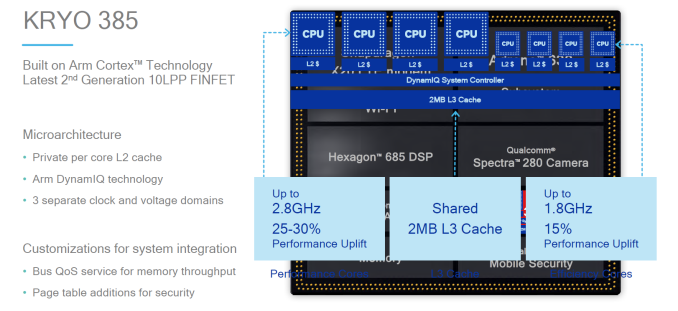
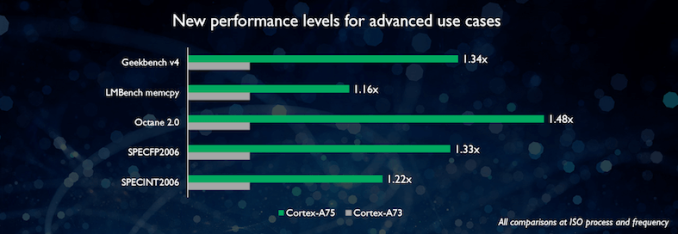
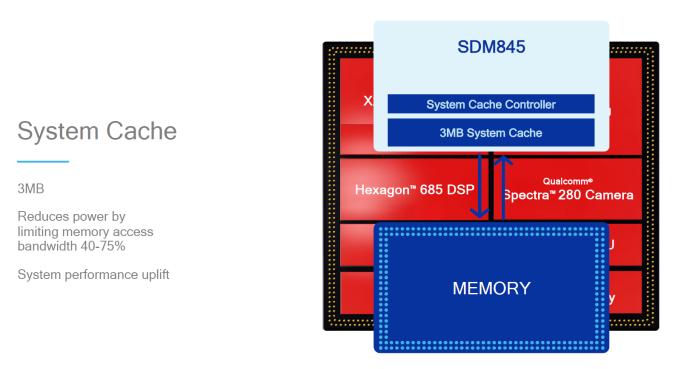
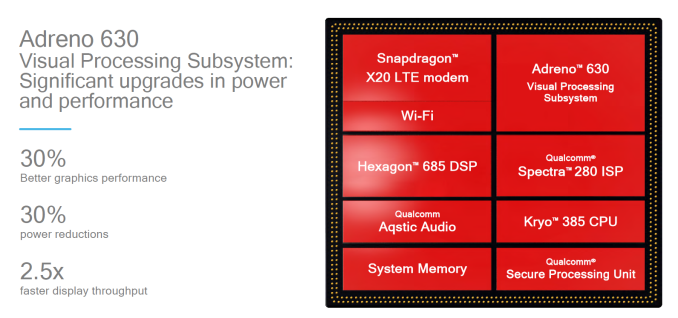

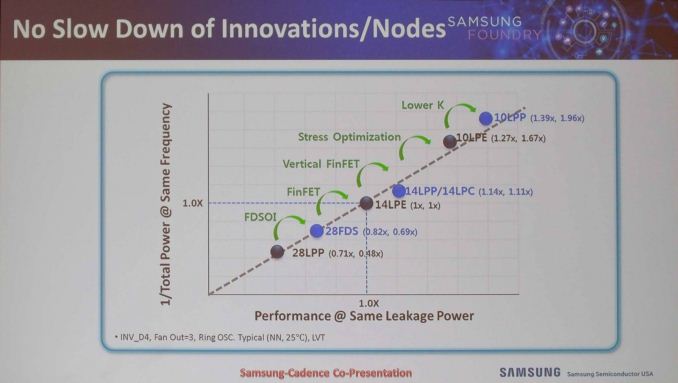








145 Comments
View All Comments
BillBear - Thursday, December 7, 2017 - link
All the nations where Qualcomm has already lost antitrust cases disagree.Currently in the US, the Federal Trade Commission is also going after them.
>The FTC alleges that Qualcomm has used its dominant position as a supplier of certain baseband processors to impose onerous and anticompetitive supply and licensing terms on cell phone manufacturers and to weaken competitors.
>Qualcomm also holds patents that it has declared essential to industry standards that enable cellular connectivity. These standards were adopted by standard-setting organizations for the telecommunications industry, which include Qualcomm and many of its competitors. In exchange for having their patented technologies included in the standards, participants typically commit to license their patents on what are known as fair, reasonable, and non-discriminatory, or “FRAND,” terms.
>When a patent holder that has made a FRAND commitment negotiates a license, ordinarily it is constrained by the fact that if the parties are unable to reach agreement, the patent holder may have to establish reasonable royalties in court.
>According to the complaint, by threatening to disrupt cell phone manufacturers’ supply of baseband processors, Qualcomm obtains elevated royalties and other license terms for its standard-essential patents that manufacturers would otherwise reject. These royalties amount to a tax on the manufacturers’ use of baseband processors manufactured by Qualcomm’s competitors, a tax that excludes these competitors and harms competition. Increased costs imposed by this tax are passed on to consumers, the complaint alleges.
https://www.ftc.gov/news-events/press-releases/201...
When CDMA tech sunsets and Qualcomm can no longer use it's CDMA patent portfolio as a price gouging weapon, their profit margins are going to plummet. There is nothing Qualcomm can do about it.
Raqia - Thursday, December 7, 2017 - link
You sound convinced it's open and shut, but it's not as monolithic an opinion as you seem to believe it is. Here's a rare written dissent by the acting chairwoman of the FTC in the specific matter of Qualcomm:https://www.ftc.gov/system/files/documents/cases/1...
and a counter statement from the Taiwan ministry of commerce regarding the trade commission's decision to fine Qualcomm:
https://www.reuters.com/article/us-qualcomm-taiwan...
Most of these government acts were the result of lobbying specifically by Apple, and the FTC lawsuit was filed on the eve of the Obama administration's departure, followed by a hasty suit by Apple. This was not a coincidence as Trump will be much more friendly to American IP.
The EU specifically lays out guidance for longer term rules that add transparency but demand calculation of royalties based on economic value added:
https://www.bloomberg.com/news/articles/2017-11-28...
Although Qualcomm will makes some concessions, its basic model will not be affected. Again, it's not about CDMA but 3G/4G LTE and negotiations going into 5G.
BillBear - Thursday, December 7, 2017 - link
Again, all the nations where Qualcomm has already lost disagree with you.Qualcomm is no longer going to be able to price gouge for a percentage of the retail price of a device when it only has FRAND encumbered patents to fall back on.
Raqia - Thursday, December 7, 2017 - link
A FRAND obligation isn't one that just takes into consideration the distorted views of large established OEMs, but it should be fair to all parties in an ecosystem. A low fixed fee with a discount for less intensive IP usage to enable competition is very fair despite some OEMs crying foul on licensing that cedes any ground to competitors. You'll note the EU agrees on some of the most important issues with Qualcomm, Ericsson, Nokia and other patent holders:https://www.reuters.com/article/us-eu-patents/eu-p...
"The Commission’s latest draft no longer has the phrase “licensing for all”, the sources said, a victory for Qualcomm as it removes the obligation on patent holders to provide patent license to all companies asking for them.
A key sentence in an earlier proposal has also been deleted, people said. The sentence said that right holders could not unilaterally set prices according to the way in which a patent is used."
BillBear - Thursday, December 7, 2017 - link
Again, the courts have already found that FRAND encumbered patents cannot be used to discriminate against your competitors and price gouge for a percentage of the retail price of the entire device.Qualcomm has already faced a string of losses in antitrust suites and really don't have a leg to stand on going forward the moment the carriers sunset CDMA.
I expect their revenues to drop precipitously from lowered patent royalties on FRAND encumbered patents vs. their current price gouging on CDMA patents, and from the companies like Samsung and Apple who will have no reason to give them any business going forward after all the bad blood Qualcomm has caused.
Raqia - Thursday, December 7, 2017 - link
Courts have found nothing as you claim, and if anything recent EU statements explicitly exclude prior language lobbied for by Apple to prevent patent holders from unilaterally setting prices the EU. The burden of proof for the use of rebates is not as cut and dry as prior regulatory decisions indicate:https://www.theregister.co.uk/2017/09/07/intel_ant...
Fines based on reasoning like this are open to appeal and closer examination. It's also much more about pricing than the moralistic jargon of Apple would have you believe, so peace to you and I'll be happy to see whatever settlement / court decision they make in this matter have the defacto say in this matter.
ABR - Friday, December 8, 2017 - link
I have to say I know far less of the details of this than either of you, but I did see that Apple basically said, "Yes, we'll pay what you ask," then went out and made massive profits and remade their entire company based on devices using Qualcomm technology, and only after that went back and cried that they were charged too much. They had every opportunity to negotiate in good faith when they made their contracts, or raise the issue with the authorities, but they chose not to. Now that they're a giant with unlimited resources for litigation, they go back and say they don't want to pay. I like Apple's technology and products, but I can't respect this practice at all.varase - Sunday, December 17, 2017 - link
I believe that FRAND terms should limit you to charging a license fee commiserate with the function you deliver to the device - in this case communications, and that that fee should be fixed for all licensees.The problem with Qualcomm licensing is it attempts to charge a percentage of the entire retail price of the device, and extorts handset makes to pay Qualcomm a licensing fee for all the innovation delivered by not only the handset maker, but any material, quality or technological improvement delivered by any other licensor or contributor as well.
There should be a fixed license cost and it should be embedded with the chip, whether it's produced by Qualcomm or some 3rd party - and there it should (by the tenets of patent exhaustion) end. No more "percentage of the retail cost of the device" nonsense which attempts to capitalize on everyone else's work.
To praise Qualcomm for changing extortion level licensing and "give a discount" is like praising a mobster for charging you $1000/day to keep your shop from burning down, and having him give your a discount because you have to live on what he doesn't take. It's simply wrong-headed.
By limiting license fees to the cost embedded in the chip, licensing is kept to a reasonable level since if the fee is excessive, Qualcomm will lose the entire feature phone price level device market as it will be eliminated if licensing fees are too high.
Raqia - Tuesday, December 19, 2017 - link
A fixed fee is indeed still functionally a percentage of the whole sale cost of a device, just higher as cost goes down. It's amazing that people buy Apple's distortion of this licensing model hook, line and sinker when Qualcomm under its FRAND obligations needs to be fair to all licensees and not just the self interested overtures of the biggest consumer electronics company in the world. To enable fairer competition, it gives makers of cheaper phones a discount off of a fixed rate.The license fee enables a network, of which the chip it sells implements only a part. (The specifics of the implementation are a separate fee in the cost of the chip, not the SEP license.) There's patents related to the cell towers as well and substantial IP in the rest of the phone's interfaces with the modem as well. As it owns the patents, Qualcomm should be free to charge what it likes so long as it's FRAND. Indeed, many models you're familiar with offer discounts for the very same service, like theaters, amusement parks for children and seniors as well as software licenses for students.
rocky12345 - Thursday, December 7, 2017 - link
Always great to see new tech and performance uplifts but I do have to question the Gold/silver usage they & a lot of others are now using in their marketing materials. I know Intel I think might have used it first with their Xeon lineup but it seems now everyone thinks oh that is so cool lets do it as well.